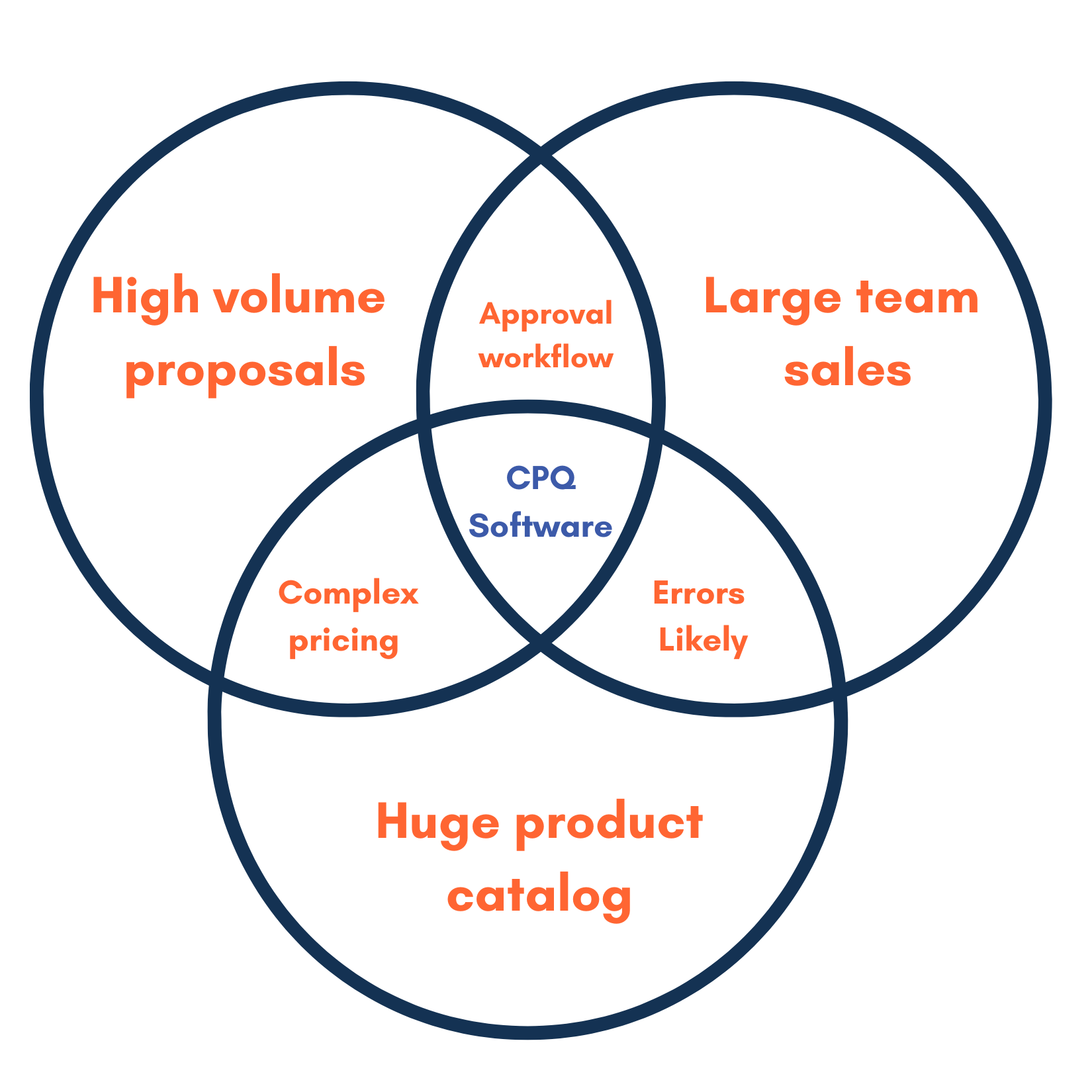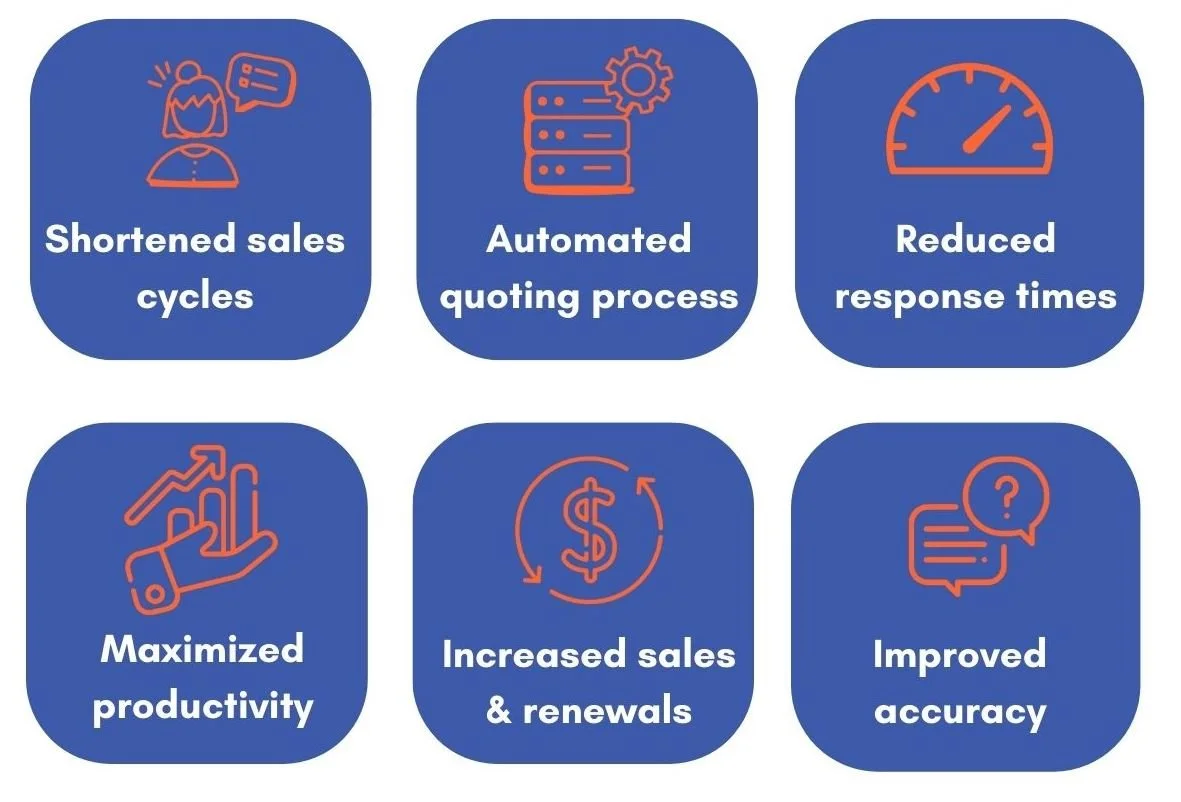A Buyer’s Guide: Key Considerations When Choosing a CPQ Solution
New to CPQ solutions and wondering how to improve your sales cycles?
CPQ solutions consolidate quoting, pricing, contracts and order management capabilities to supercharge sales productivity with control.While configure, price, quote (CPQ) solutions have helped streamline sales workflows for decades, the latest wave of intelligent CPQ innovation represents the cutting-edge in optimizing sales productivity and profitability.
In this resource, we will discuss the benefits of CPQ solutions for empowering modern sales teams with accurate data, key considerations for a successful integration, and tips for future proofing your CPQ solutions, as your business scales.
How to Improve (and Empower) Modern Sales Teams with CPQ
For modern sales teams, CPQ can help with product configuration, automatic discounts, compliant customer terms, and integrated sales operations workflow to arm your field teams to convert opportunities accurately at scale while protecting margins performance.
Industry studies indicate sales representatives only allocate 34% of their total workload to direct selling activities. Further analysis highlights that a material portion of non-selling capacity gets occupied by manual quote creation, proposal generation, and chasing product approvals. Fundamentally, CPQ brings real-time visibility into sales pipelines, empowering you as a sales leader to identify bottlenecks and calibrate data-backed strategy shifts for your teams. The embedded analytics also reveal customer behavior insights for refining future go-to-market motions.
But when it comes to efficiency, CPQ solutions streamline the entire lifecycle from configuring complex solutions to automating accurate pricing and quotes, relieving administrative burden so teams can focus energy on selling rather than manual tasks. We know accuracy and pricing mishaps erode customer trust over time - CPQ delivers consistency by capturing nuances around preferences and patterns in customer buying journeys, CPQ insights inform everything from performance trends to future business decisions with a 29% increase in accurate forecasting.
When considering how to continuously improve your sales teams, visibility and efficiency always need to be top of mind. But technology doesn’t prop itself up. You need humans and this is where challenges (and opportunities) come into play.
CPQ software sits at the center of large teams looking to manage growing products and high volume proposals.
Key User Considerations for a CPQ Integration That Scales
A major challenge that I have seen from my experience implementing CPQ solutions is user driving user adoption. We know that in this tech climate, budgets are tight so if you have invested in the solution, you had better make sure that your teammates are too! When integrating CPQ with other enterprise systems such as ERPs and CRMS, you will always want to understand your broader business processes and how to scale, while considering data quality, security, and user adoption.
For a smooth integration, you need to have clearly defined objectives. Clearly defining the rules and dependencies before implementation is important and this is why I spend time in discovery with my clients. Also, avoid overly complex rules, which can make the system difficult to manage and lead to unintended consequences.
Once those are clearly outlined and the integration goals and objectives are outlined, and you understand what data needs to be shared between systems, you just have to establish a roadmap for the integration process. Maybe you choose Salesforce, or maybe you choose a different solution, but flexibility needs to be a key and Salesforce has always been the most flexible for me when implementing solutions for clients.
But your automation cannot happen without standardizing data formats and you have to ensure that the data and structure are standardized across your systems. This will speed up your integration process and reduce any likelihood of errors. I always recommend investing time to define and build a comprehensive data mapping strategy to optimize data quality and that the data from your CPQ solution aligns with the formats and structures of the other systems in your business.
Next, when considering prioritizing the security of your data during integration, I recommend implementing encryption protocols and ensuring that access controls are in place. Once implemented, invest any resources that you can in rigorous testing before and after integration to identify any issues, including user acceptance testing, unit testing, integration testing, and UI. Test the rules thoroughly in your sandbox environment before deploying to production. As your org scales (more tips on this later) implement version control in your CPQ configurations before deploying any changes to the production environment. You want to thoroughly test your configures in your sandbox environment to ensure that the updates align with business needs and no unexpected changes occur.
All of these steps are necessary to validate a seamless workflow of data between the systems. However, the one area that I consistently see clients failing to invest resources in documentation - an essential part of any scalable user adoption. If you invested this much time and money from your budget into automation, why would you not want to ensure that your cross-functional leaders have an understanding of your data mapping, integration, workflow and configurations? This documentation is invaluable when it comes to successfully integrating your CPQ solution. But now that you have configured your new tool, you may be wondering if your solution is even usable?
Fortunately, if considering Salesforce, their CPQ has a very user-friendly interface, which should help with increasing adoption, but do not skimp on the training to understand core functionalities. In addition, have a plan with your implementation partner to ensure that you are documenting training so that your teams are empowered and new members being onboarded also have access to live documentation. Remember that a lack of documentation makes it challenging for administrators and new team members to understand and maintain rules. If any rules have been changed, you will want to make sure that you update the repository with that change.
Ignoring User Feedback Will Cost You
As your business grows, so will the complexity of your integrations, your volume of data, and rules. You cannot ignore user feedback - ignoring feedback from users who work with the CPQ system can result in rules that do not align with the practical business needs. So regularly gathering feedback from end users and administrators, using their insights to refine, and optimize rules for better alignment with business processes is important.
Big or small, for any sort of change, make sure there's communication, because frequent changes without communication will lead to stakeholders getting very confused. So it's good to establish a clear communication plan for rule changes and notify stakeholders in advance, especially if their changes may impact their workflows.
Future Proofing Your CPQ Solutions Requires Maintenance.
Let’s face it. Ongoing maintenance and enhancements are crucial for a healthy CPQ platform. For best practices to help ensure the CPQ platform continues to meet evolving business requirements over time, be proactive! To address CPQ data quality issues, regularly conduct regular data audits.
Also, this part goes without saying, but to foster a culture of continuous improvement for data quality processes, that's very important. Remember that when implementing any sort of validation rules and data governance policies, you must continue to provide comprehensive user training, while automating any sort of data entry processes that you can to reduce manual workflowers, and monitor and vigilantly monitor system logs for any anomalies.
If you want to truly protect and future proof your CPQ investments for the long-term, make sure that the CPQ solution is scalable. This takes us back to the discovery process mentioned and when planning, always taking into account the ability to handle increased data volumes, user numbers and additional features without actually sacrificing the performance. And again, the obvious, but it bears repeating! Establish and implement a clear communication strategy to keep all stakeholders informed about any changes in corporate directives and how they impact the CPQ platform. Make sure you follow open lines of communication between business leaders, IT, and your end users.
Conclusion
Tight budgets can make sales leaders think twice about investing in new technology and prices, but the long-term cost-savings in efficiencies for your teams and end users, as well as shorter sales cycles are worth it. At Kander, we do not only implement your automation efficiently and quickly to match your business requirements, but help you architect a solution that will grow with your business. In addition, we provide the technical training and information to empower you and your teams to maximize your investments in whichever CPQ solution you decide is best for your business.
Let our CPQ automation experts help you scale results for your teams and business.



